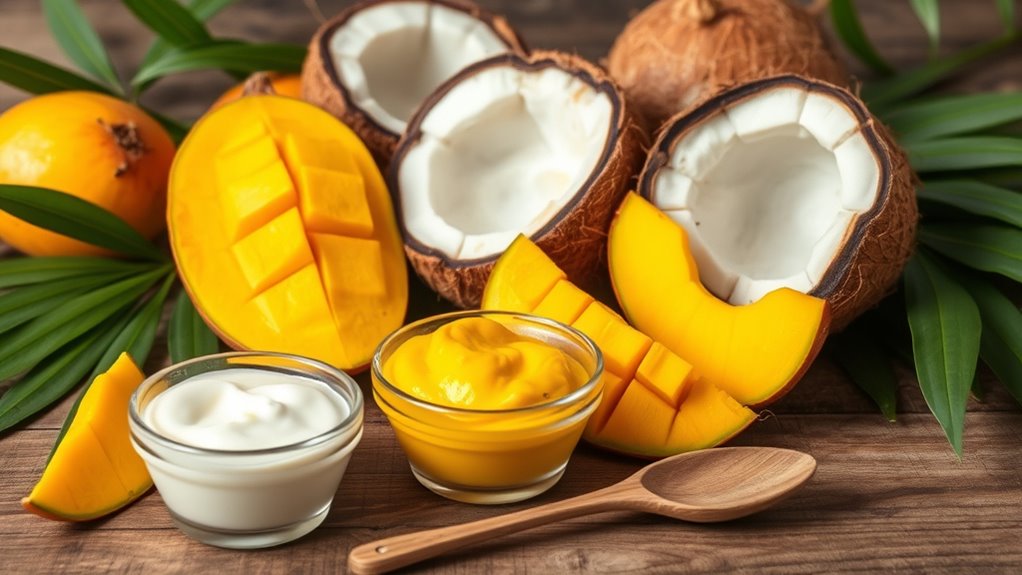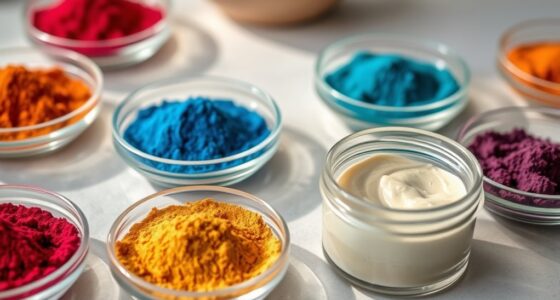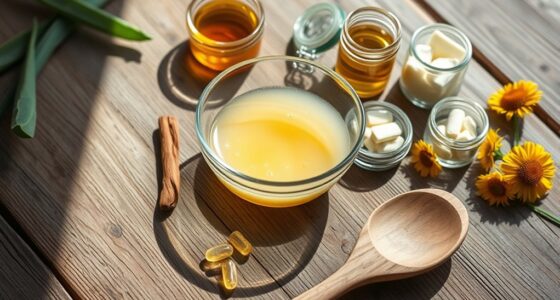You can boost your hair’s health naturally by creating DIY masks with tropical fruits like mango and coconut. Use ripe mangoes blended with coconut oil or yogurt to hydrate and repair damaged strands. Apply the mixture to damp hair, leave it on for 20-30 minutes, then rinse thoroughly. These ingredients nourish from within, promoting shine and strength. Keep exploring different recipes and tips to transform your hair care routine further.
Key Takeaways
- Use ripe mangoes blended with coconut oil or yogurt for a nourishing, hydrating hair mask.
- Apply the mixture to clean, damp hair and leave on for 20-30 minutes before rinsing thoroughly.
- Combine mango with honey or banana for added moisture and shine enhancement.
- Use homemade tropical fruit masks once or twice weekly for optimal hair health benefits.
- Rinse well to prevent residue buildup and maximize the nourishing effects of natural ingredients.

If your hair feels dull, dry, or damaged, creating DIY hair masks can be an effective way to restore its health naturally. Tropical fruits like mango and coconut are packed with nutrients that nourish your hair from within. The benefits of natural ingredients are well-documented—they’re gentle, free of harsh chemicals, and provide hydration, shine, and strength. When you incorporate these fruits into your hair care routine, you’re giving your strands a boost of vitamins, antioxidants, and fatty acids that promote overall scalp health and hair vitality.
Mango is rich in vitamins A, C, and E, which help repair damaged hair, boost shine, and combat frizz. The natural sugars in mango act as humectants, drawing moisture into your hair strands and preventing dryness. Coconut, on the other hand, contains lauric acid and saturated fats that penetrate deeply into the hair shaft, strengthening strands and reducing protein loss. Its antimicrobial properties also soothe the scalp and reduce dandruff. Using these ingredients in homemade hair treatments is simple and cost-effective. For example, blending ripe mango with a bit of coconut oil creates a nourishing mask that you can apply directly to your hair.
When making your DIY hair masks, keep in mind some homemade hair treatment tips. Always start with clean, damp hair for better absorption. Choose ripe, juicy mangoes—they’re softer and easier to blend. Mix the fruit with ingredients like coconut oil, honey, or yogurt to enhance the moisturizing effect. For example, a simple mask could be mashed mango combined with a tablespoon of coconut oil, left on your hair for 20-30 minutes, then rinsed thoroughly. This treatment helps restore elasticity, smoothness, and shine. Be sure to rinse out all remnants of the mask to avoid residue buildup. Incorporating natural ingredients into your routine can also help reduce exposure to synthetic chemicals often found in commercial products.
You can also experiment with other tropical ingredients, like banana or pineapple, to customize your mask based on your hair’s needs. Applying these masks once or twice a week ensures consistent nourishment without overwhelming your scalp or hair. The key is to use natural ingredients that are fresh and free from preservatives. Homemade hair treatment tips like gentle application, proper rinsing, and regular use will maximize the benefits of these tropical treats. With patience and regular care, your hair can become softer, more vibrant, and healthier—all thanks to the power of natural, tropical ingredients.
Frequently Asked Questions
How Often Should I Apply Tropical Fruit Hair Masks?
You should apply tropical fruit hair masks about once a week for ideal results. This application frequency allows your hair to benefit from nourishing ingredients without overloading it. The best timing is after shampooing, when your hair is clean and ready to absorb nutrients. Keep an eye on how your hair responds; if it feels weighed down or greasy, extend the interval between treatments.
Can I Combine Multiple Tropical Fruits in One Mask?
Yes, you can combine multiple tropical fruits in one mask. Mixing tropical fruits like mango and coconut offers added benefits, such as a richer source of vitamins, antioxidants, and hydration. This fruit combination benefits your hair by nourishing, strengthening, and moisturizing it deeply. Just make sure to blend the fruits well and use fresh ingredients for the best results. Experimenting with different fruit combinations can enhance your hair’s overall health and shine.
Are There Any Allergic Reactions to Mango or Coconut in Hair Masks?
You might experience allergic reactions or skin sensitivity when using hair masks with mango or coconut. Always do a patch test before applying the mask fully—apply a small amount to your skin and wait 24 hours. If you notice redness, itching, or swelling, avoid using these ingredients. Everyone’s skin reacts differently, so it is crucial to be cautious, especially if you have known allergies to tropical fruits.
How Long Should I Leave the Mask on for Best Results?
For best results, you should leave the mask on for about 20 to 30 minutes. The application duration allows the nutrients from mango and coconut to deeply hydrate and nourish your hair. For ideal timing, cover your hair with a shower cap to trap heat, enhancing absorption. Rinse thoroughly with cool water afterward. Avoid leaving it on too long, as it can cause scalp irritation or weigh your hair down.
Can Tropical Fruit Masks Help With Dandruff or Scalp Issues?
Tropical fruit masks can help with dandruff and scalp issues by promoting scalp hydration and soothing irritation. Mango and coconut contain antioxidants and moisturizing properties that may reduce dryness and flakes. You’ll notice dandruff relief as these masks nourish your scalp and restore balance. Incorporate them into your routine a few times a week, and you might see an improvement in scalp health and a decrease in dandruff over time.
Conclusion
Now that you know how to whip up hair masks with tropical fruits like mango and coconut, you’re all set to give your hair the boost it deserves. These natural remedies are easy, affordable, and packed with nutrients. Remember, patience is a virtue—don’t expect miracles overnight. With consistency, you’ll see your hair flourish. So go ahead, dip into these tropical treasures and let your hair do the talking. It’s time to turn over a new leaf!









